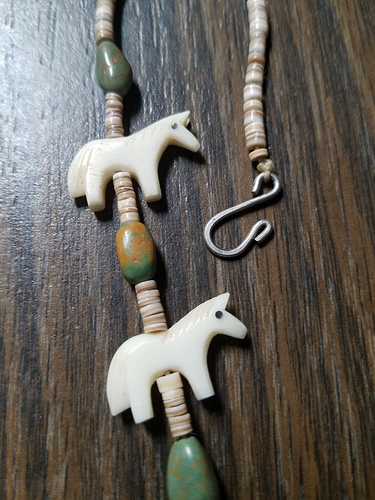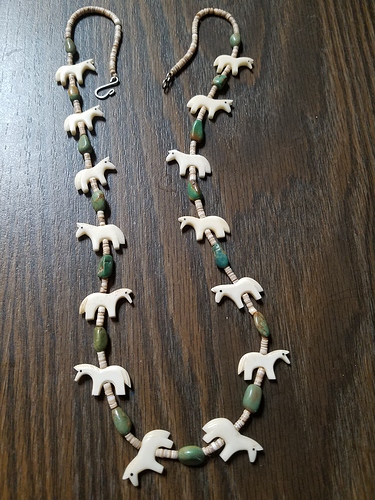these have a great look to them, especially if you are a horse lover. the greenish stones may well be turquoise, and the horses may either be bone or faux ivory/resin. hard to tell. there are heishi experts here who can tell you more about the shell used, but my overall impression is that this is an import piece, or at least made up of import components. Probably impossible to identify who it was assembled by.
Fetishes look template cut. Heishi looks commercial grade, as do treated turquoise nuggets. All or most of the work is done by someone by hand, but without knowing who did the work/stringing, it’s impossible to know if this piece is native made and/or native strung.
Note that some of the individual shapes are a little different, as are the carved details, I would say these are not template cut.
The inlayed eyes are not typical for low cost fetishes.
Can you do a heat test to the back of one of the horses? This could help determine what material it is.
The heishe appears to be typical from the Philippian’s. I have some vintage 1980’s that is identical. This was commonly used and available on the Navajo Nation when I lived there in the 1980’s.
Many Navajo artists assembled necklaces made from purchased items.
I love this necklace, as I am a horse lover and have some.
“Inlaid” eyes would often be done with something like a Sharpie marker. I worked in Zuni for many years, and a dab in the eye recess with a Sharpie was how many of the fetish makers would create the look of inlaid eyes. Don’t know if that’s how this one was done, but the practice was pretty common.
in terms of the way templates are used, only the rough outline is drawn on to a slice of stone or piece of shell - once again with a sharpie marker - to make roughing out the shape on the grinder faster and easier. All of the actual carving work is done by hand, and more than one sized template can be employed when creating graduated pieces.
Heishi does look Philippine. Back in the early 70’s Philippine heishi used to come in by the 5 gallon bucket load pre-strung on steel wire. From there production shops would string it with pre-made fetishes, or turquoise nuggets to make chokers and necklaces. Back when I worked for Sunrise Traders running their jewelry production shop, Navajo craftspeople would string up big grocery sacks full of fetish and nugget chokers and necklaces (paid by the piece), which we would wholesale by the sack full to outfits like Tobe Turpens, Atkinson Trading, Richardsons, M&M Trading, J.B. Tanner, and dozens of others.
Note: The horses look like they’re cut from shell, and if so you don’t want to put a flame to them, as natural sea shell can burn and discolor pretty easily.
Agree with Mmrogers. Most randomly acquired fetish necklaces are commercial, often of imported origin or with imported materials, and not Zuni–the tribal origin of authentic, quality fetish necklaces. (Yes, Navajo makers cranked them out for sale, but it’s not a Navajo jewelry form.) This is one such non-Zuni product.
I had posted a link in another thread for a Navajo artist who does inlaid fetishes. They contain two different stones and or shell, plus inlaid stone for the eyes.
I do not want anyone to assume that the eyes are black sharpie marker. If they are above the surface, that would indicate that something was inlaid. Unless it is a drop of black tinted glue.

